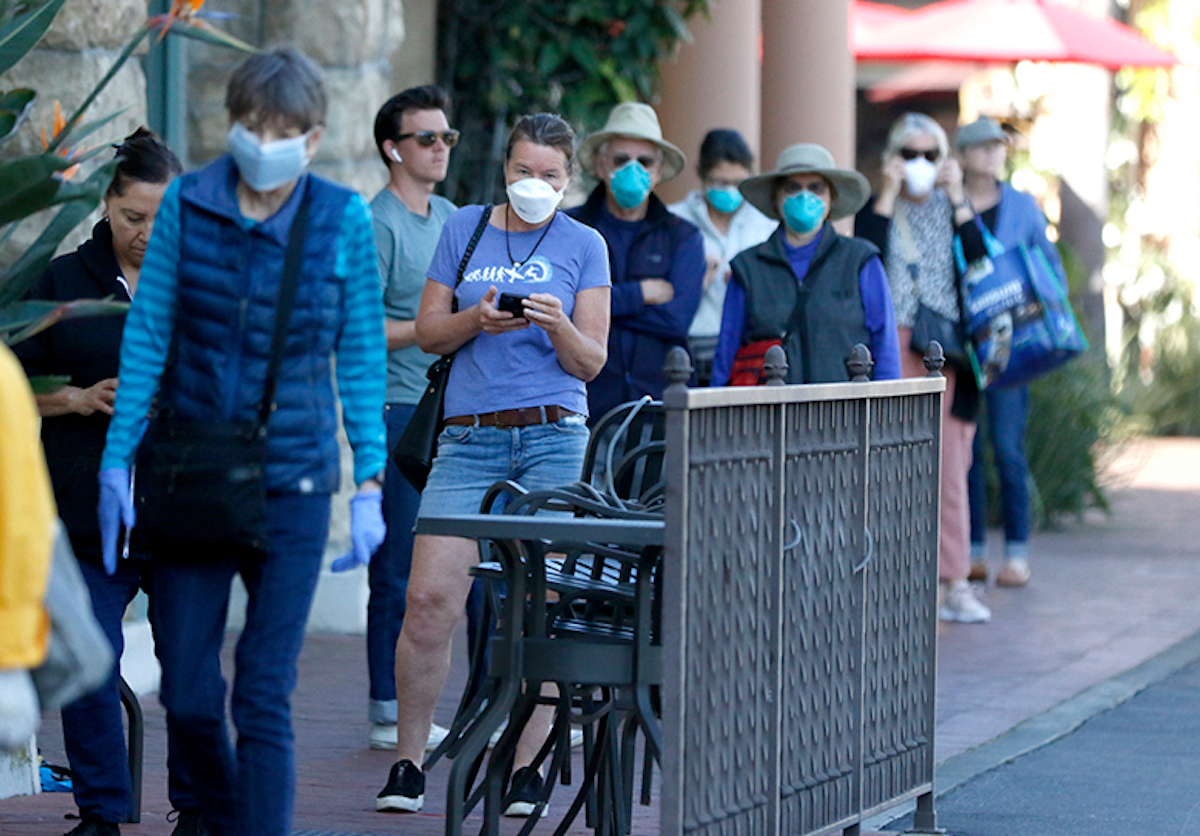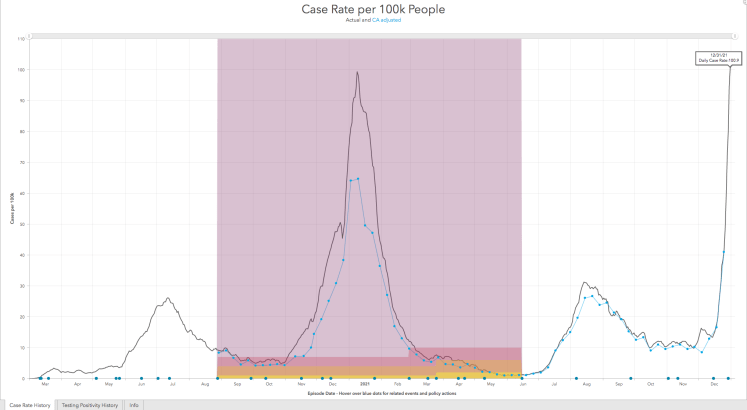Santa Barbara’s Omicron Case Rate Shoots to the Sky
Hospitalizations Also Increasing

Blame it on the Omicron. COVID case rates worldwide and in Santa Barbara are tracking in a straight line skyward. Worse, the number of patients in hospitals is increasing.
Dr. Henning Ansorg, the county’s public health officer, said in a recent interview that the case rate had leapt upward starting in mid-December. “Remember when we were discussing lifting the mask mandate at a case rate below seven?” he asked. “Now we’re at 100!”
In California, the variant jumped from 1.4 percent to 6.5 percent to 15.7 percent of genetically sequenced cases over the last three weeks of December. Of the five known Omicron cases in the county, one person is vaccinated, and four are not.

“Omicron is really like a new virus,” Ansorg said. Compared to the original virus and subsequent variants, people who now become ill with Omicron can be treated, he noted. Vaccines also offer significant protection, especially with a booster shot, and fewer people are being hospitalized. People do experience body pains, he said, but preliminary studies indicate Omicron is less damaging to lung tissue.
The rapid spread, however, is affecting hospitals and hospital workers. Countywide, hospitalizations jumped from a two-week average of 46 up to 60 on January 4. At Cottage, the before-Christmas COVID patient count was eight; right now it’s 23, with one person in critical care. The building surge is so great that Cottage stopped allowing visitors on Wednesday.
At Marian Regional Medical Center in Santa Maria, staffing in many departments is affected, said CEO Sue Andersen. Daily operations continued normally, but they were keeping an eye on the number of elective procedures. About 5 percent of all employees were down with COVID at Lompoc Valley Medical Center, said CEO Steve Popkin, both clinical and non-clinical staff. “The staff is stressed, but they are doing incredible work just dealing with the job in front of them and moving forward,” he said.
Sign up for Indy Today to receive fresh news from Independent.com, in your inbox, every morning.
For anyone who’s woken up with a scratchy throat or serious body aches this week, they know getting tested takes time. Public Health’s website is deluged with appointment requests and currently scheduling one and two weeks out; lines of cars snake down the roads outside its testing sites. Private urgent care centers and doctor’s offices are providing tests, some reportedly for as much as $180.
Sansum, the largest private clinic in the county, is at unprecedented levels of appointment and test requests and of visits to its Urgent Care by their patients, said spokesperson Jill Fonte. She noted that despite the increased number of positive tests they are recording, they know even more go unrecorded with the availability of home tests. And such is the demand that Fonte said Sansum was unable to accommodate people who wanted to verify a positive home test result.
Fortunately, the quick tests available in drug stores work for Omicron, said Zach Aralis, a grad student in molecular biology who is part of the virus sequencing team at UC Santa Barbara. They may not be as sensitive as the PCR test, but a positive quick test is very likely to be accurate, especially if you’ve been sick for three to five days and have a good viral load in the sample. (Two kits, however, do not work. The Food and Drug Administration advised on December 27 that Meridian Bioscience’s Revogene test and Applied DNA Science’s Linea Assay Kit do not detect Omicron.)
All test kits are in short supply internationally, but health-care centers and schools are federal priorities to get them in about 10 days’ time, Ansorg said, adding, “Trust the at-home test.” They reinforce quarantines — the new standard is five days — that keep other people from getting infected. If an exposed or symptomatic person decides against testing, the quarantine period is 10 days.
If the results in South Africa, where Omicron was first identified, hold true for Santa Barbara, the sheer number of people infected will hurt elderly individuals and people with weak immune systems, Dr. Ansorg said, and having no vaccination or booster put people at the greatest risk. But anyone who’s recovered from Omicron should have robust protection against Delta, he said, looking ahead, “Or a variant like Delta, or whatever comes next after Omicron burns through.”
[Update: Jan. 6] California’s public health website redesigned its variant page and refreshed the information on January 6. Omicron represented 74.7 percent of sequenced samples as of December 29 in preliminary data. The last complete data set is for December 26 and shows 75.6 percent Omicron. The remaining variant of concern for each date is Delta. Roughly 10 percent of positive COVID-19 tests are sequenced, and the percentage is a seven-day average. According to today’s update, the percentages reported earlier in this story conform to the first half of December.
At the Santa Barbara Independent, our staff continues to cover every aspect of the COVID-19 pandemic. Support the important work we do by making a



You must be logged in to post a comment.